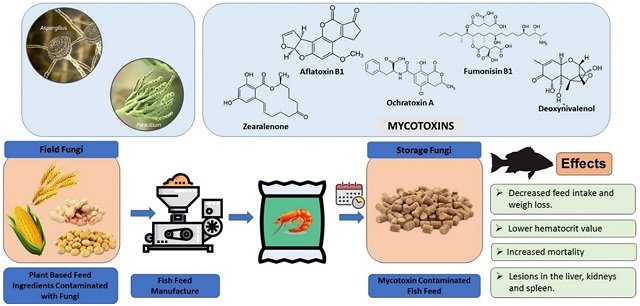Bergen, Norway.- So far, fish have been spared the problem of mycotoxins produced by mould, but the increase of plant ingredients in farmed fish feed has resulted in more such toxins in fish feed too. Many ‘new’ toxins have been discovered, and we know little about any consequences they may have for fish and people.
Toxins produced by mould, also known as mycotoxins, have long been a known risk in human food and land animal feed. The annual feed monitoring programme, which is carried out by NIFES on behalf of the Norwegian Food Safety Authority, has found that these toxins are now becoming more common in fish feed as well. More than half of fish feed ingredients are now of plant origin, and they bring mycotoxins. This presents new challenges, both as regards the health of farmed fish and food safety.
It is common knowledge that you shouldn’t eat mouldy food and that mycotoxins can be harmful to humans. Some types of mould in food are known to cause serious health problems. It is not necessarily the mould itself that is the problem, but some of the toxins that it produces.
Animals have different tolerance to these toxins, and some species are more sensitive to them than others. Studies carried out to assess how toxic certain mycotoxins are to different species of fish have shown that rainbow trout is particularly susceptible. Since salmon is a close relative of the rainbow trout, it is assumed that salmon could also be sensitive to these toxins, but we need more knowledge about this.
Over the past ten years, the mould and mycotoxin content in Norwegian grain products has increased. Several studies predict a global increase in mycotoxins as a result of climate change, and a warmer and wetter climate can also make moulds a greater problem for the salmon industry. The amount of plant ingredients in salmon feed is increasing, and these ingredients are probably the main source of the most well-known mycotoxins in salmon feed, but mould can also occur in other feed ingredients.
Many ‘new’ mycotoxins produced by mould have been discovered recently, but, so far, we know little about how they affect salmon. Some of the ‘new’ mycotoxins are more fat-soluble, which means that there is a possibility that they can accumulate in farmed fish. If that is the case, then the levels of individual mycotoxins can increase over time. We know from research on other animals that mycotoxins affect feed utilisation and the need for nutrients such as vitamins A, C and B.
So far, a maximum limit for mycotoxin content in complete feedingstuffs has only been set for one mycotoxin, namely aflatoxin, but the EU has made recommendations for five other mycotoxin groups. The ‘new’ mycotoxins are not covered by these recommendations. In addition, the Norwegian Scientific Committee for Food Safety (VKM) carried out an extensive risk assessment of mycotoxins in food and feedingstuffs for salmon and other livestock in 2013. The assessment showed that the assumed maximum levels of these known mycotoxins in salmon feed do not represent a risk to fish health.
Stay Always Informed
Join our communities to instantly receive the most important news, reports, and analysis from the aquaculture industry.
However, the latest feed monitoring results uncovered higher levels of mycotoxins than assumed in the 2013 risk assessment. The report from 2013 also identified several knowledge gaps when it came to the effects on salmon health, and particularly the effects of the ‘new’ mycotoxins. The maximum limits and recommendations are also mainly based on knowledge about land animals, not salmon.
As a research institution tasked with providing knowledge support to the public administration, NIFES shall stay one step ahead when it comes to knowledge about potential risks in the food chain. In order to safeguard the production of safe seafood, it is now vital to gain an overview of the situation and ensure good control of risk factors in food and feed ingredients.
Contact
Kai Kristoffer Lie
Scientist (PhD)
E-mail: KaiKristoffer.Lie@nifes.no
Telephone: +4795219873
Source: NIFES
Editor at the digital magazine AquaHoy. He holds a degree in Aquaculture Biology from the National University of Santa (UNS) and a Master’s degree in Science and Innovation Management from the Polytechnic University of Valencia, with postgraduate diplomas in Business Innovation and Innovation Management. He possesses extensive experience in the aquaculture and fisheries sector, having led the Fisheries Innovation Unit of the National Program for Innovation in Fisheries and Aquaculture (PNIPA). He has served as a senior consultant in technology watch, an innovation project formulator and advisor, and a lecturer at UNS. He is a member of the Peruvian College of Biologists and was recognized by the World Aquaculture Society (WAS) in 2016 for his contribution to aquaculture.




